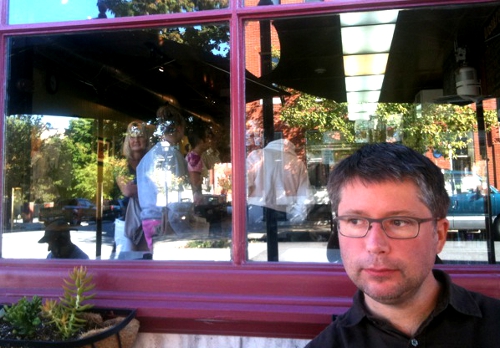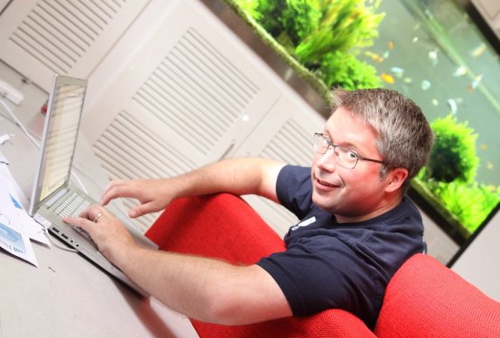- How Is Dave Troy’s Company Mailstrom Making It Easy To Filter Thousands Of Emails At Once?
- What Are Effective Approaches For User Testing In Product Development?
- Learn How The Baltimore Internet Community Is Building Itself Up
Full Interview Audio

Personal Info
Sports Teams:Baltimore Ravens
Favourite Books:
- Only The Paranoid Survive: How to Exploit the Crisis Points That Challenge Every Company by Andrew S. Grove
- The Idea Factory: Bell Labs and the Great Age of American Innovation by Jon Gertner
- The Death and Life of Great American Cities by Jane Jacobs
Most Influenced By:Jack Dorsey, Dave McClure
Twitter: http://twitter.com/davetroy
Personal Blog: http://davetroy.com
Website: http://410labs.com
Relevant Link: http://mailstrom.co
Interview Highlights
This is a condensed, lightly edited transcript of an audio interview. The full audio is available and highly recommended. The interviewee may post clarifications in the comments.
Adrian Bye: Today I’m here with David Troy. He runs 410 Labs, based out of Baltimore. David, thanks for joining us. 
David Troy: Thank you, Adrian, glad to be here.
Adrian Bye: Tell us a little bit about who you are and what you’ve been up to.
David Troy: I’m kind of a geek, technology entrepreneur based in Baltimore, Maryland. I’ve been a serial entrepreneur since I was a teenager, and my latest company is called 410 Labs. We founded the company, my partner Matt Koll and I, back in 2010 around the idea of really looking for interesting ideas that could be made into products. We set out to develop three different ideas that we’ve been working on, one of which is called Replyz, which helps people get answers to questions that they might not otherwise get using things like Twitter. The other is called Shortmail, which is kind of a short messaging service that’s based on email. And the latest one that we’re spending a lot of time on and that is getting a lot of traction is called Mailstrom. Basically, it enables people to better handle large volumes of emails, sort of a machete or machine gun for going into a big overrun mailbox.
Adrian Bye: In the past you did something on Twitter that got a lot of traction.
David Troy: Yes, back in the very early days of Twitter I was one of the first people to develop something using the Twitter API, and that was called Twittervision. It was a kind of visualization of all of the traffic that was happening on Twitter at that time. At that time it was a relatively small amount of volume so you could actually see all the tweets happening all around the world on a map in real time, which gave people an early sense of what the possibility of Twitter might be. It was used in a lot of news reports about Twitter at that time to help explain the concept. As part of that I got friendly with the Twitter team and got really bit by the bug of wanting to build products and things on the internet. The notion that you can build something and then have in front of this audience of millions of millions of people almost overnight really appealed to me. That kind of laid the groundwork for what I’m doing now.
Adrian Bye: I saw when you started Shortmail. Shortmail was your idea of being able to do short responses to email.
David Troy: Basically, the idea of it was we believed that a lot of the reasons why email behaves the way it does or why people interact the way they do is because of the way it was designed. There is a lot of design constraints that go into email, many of which we don’t consciously think about. But if you think about the idea that anybody can send you an email at no cost to them, and in fact it puts kind of a cost on you to have to process it, there is some basic asymmetries in how that works. So we thought, well, what if we were to create a platform where we could experiment with some of the design parameters of email and one of the most interesting things that we thought would be worth playing with was just the idea of message length. I know in my own experience if I receive a short, concise email I’m much more likely to respond to it quickly than I am to somebody sending me a multi-page long essay. 
Adrian Bye: Tell us about Mailstrom.
David Troy: Mailstrom is a little bit different concept. Rather than do something totally new and different, let’s make the existing email landscape a little bit better. I don’t know how many emails are in your inbox right now, but there’s a lot of people who have a thousand emails in their inbox, ten thousand emails, some people never remove anything from their inbox, let everything kind of flow past them and then search for what they need and respond only to stuff from the top page. There are so many different strategies that people have evolved to cope with email. Anybody who goes on vacation for a week comes back to find hundreds of emails in their inbox, possibly thousands. We felt like the existing tools for managing that heavy flow of inbound email were really pretty inadequate and very unimaginative in terms of how they work and what could be done.
With Mailstrom we focus on the fundamental insight that there is no such thing as just one message a lot of the time, it’s very much about bundles of messages. If you have like twenty emails from your wife or fifty emails from Groupon or thirty emails from ebay, or a hundred messages from Facebook or Twitter, those things can all be related together by way of their common sender, their common mailing list id, or the subject line. We basically took a whole bunch of those fairly common ways of grouping messages together and made that super easy to do. Let’s say you have ten thousand emails and you go into Mailstrom for the first time. You immediately see the top senders that you have in these ten thousand messages grouped by the most common one, which might be 500. The next common might be 450 or something. And then you can quickly archive, delete or label any of those bundles and take your ten thousand message inbox down to like 150 messages in just a few clicks, because you’re acting on the large head of the email. And that kind of leaves the longtail that actually requires your attention. Depending on email flows, we have users that use it every day, use it once a week, and some users use it once a month. We have users that use it after they come back from vacation, some users that use it on accounts that got unruly for whatever reason.
We really like to build something that contributes to the body of knowledge on this, makes people’s lives better. At the end of the day we think if you can make email enough better you will actually improve people’s relationships because that’s really what people do with email, at least email between people and people is conduct relationships, some to the extent that if we can help people respond more quickly and be more responsive, then we improve relationships. It strikes me as a worthy goal. 
Adrian Bye: Is there anything else that you want to tell us about Mailstrom?
David Troy: Well, just that it’s exciting. We spend a lot of time doing customer-driven development which a lot of people talk about but few people actually sit down and do. We actually did a lot of user testing, having users come in live watching them use the product. We did seventeen rounds or so of surveying to try to figure out exactly how we can improve the products and where we were succeeding. It seems to really have paid off because now we’re starting to get more traction with some processes and things like that. People are just loving the product and they are explaining to other people about how much they’re loving the product, which is great. We feel like we’re really contributing to happiness in the world, which is a good thing.
Adrian Bye: Can you walk me through how that worked?
David Troy: In terms of the customer development process?
Adrian Bye: I’ve just changed my religion to Lean. I went through one of their workshops and it was amazing. I learned a lot of those sorts of techniques through direct response marketing, but that’s just on the sales side. I never learned it on the product development side and that was incredible. So I’d like to hear what you guys have been doing and how you’ve been applying it.
David Troy: The current practice-du-jour in the startup world is this idea of Lean Startup. Often people say it without thinking about what it actually means in practice. The truth of the matter is it’s really rigorous and it’s hard work. I wouldn’t say that we necessarily have subscribed to any particular ideology on it, but I would say that we were really rigorous about conducting just many rounds of experiments. And that’s really what it boils down to at the end, conducting experiments and seeing how your changes affect the outcome with users. We had developed the basic concept of Mailstrom almost two years ago. We had put it on a shelf because there were some technical issues that we knew we had to sort out before we could return to it, so we got started with it again last year. We just threw it out to a community of people and see what reactions we’d get about different aspects. There were some pretty serious technical problems with it that we knew existed, but it wasn’t worth going fixing everything so we knew a little bit more what direction to take in that. We just put it out there and literally sent it to some mailing list of people who are affiliated with some investors that we work with and said, ‘here, keep your tires on that thing and tell us what you think and fill out the survey’. And the early survey results were brutal, just awful, like ‘that is the worst product I’ve ever seen, horrible idea, terrible execution, it looks ugly’. 
Adrian Bye: Before you go on, how did you get those users just to even go through that? I mean, people don’t like just filling stuff in. What was their motivation?
David Troy: As I mentioned, we have some investors, and each of them maintains a kind of founder community where you can just have conversations with other founders and get feedback. We started there and with family and friends, and local people, people that were willing to go through our painful process and had them kick the tires on it and tell us what they thought. And they were absolutely brutal in their responses, which was great because it gave us a very clear idea what specifically about the concept needed work, specifically around the execution, and the design needed work. And then we just started systematically. How do we start overcoming these objections?
The other thing we did was bring in users to come in live and try it. One of the things that you learn with that that you don’t learn from doing online testing is people who have a bad experience online just kind of drift away and don’t really give you any feedback. The people who have a great experience will send you an email and kind of reinforce your own biases around the product, but you never really hear that brutal ‘that doesn’t make any sense to me, I don’t use email this way, I don’t do this, I don’t do that. What happens when I click on this? That didn’t work on my Windows PC’, or whatever it is. You’re just not going to hear a lot of that feedback. So what we found was really very viable. We brought in users out from the wild, and we literally found them on Facebook and locally: ?Hey look, we’re going to give you free pizza if you come in and try this, and it will help you clean up your emails?. So they would come in and we would have our engineering team sit and watch the users as they try to use the software that they’d built. There is nothing more humbling than for an engineer or an architect to look at what people actually go through when they try to use your stuff. All the things that you think should be obvious and intuitive turn out just not to be. And people are really struggling. These are not stupid people either. These are people that are familiar with technology, use technology products all the time, but in order to divorce yourself from the biases that we all carry around our own products and also about how we think things should work, there’s nothing more viable than watching people use your products.
Adrian Bye: Is there anything else that you want to tell us about Mailstrom because I have another big topic that I want to ask you about?
David Troy: Just Mailstrom is growing like crazy. We got some press like Livehacker like five weeks ago and that has taken off just dramatically. So it’s like a 525% in five weeks. And as of this moment helped people clear out like 105 million emails from their inboxes, which is pretty cool. We’re just excited to see what’s next. It has the air of a product that’s got a nice hockey stick curve going for it and we want to see how far we can take it.
Adrian Bye: For me a very interesting topic is Baltimore. You’re someone that is really pushing the tech community in Baltimore, actually almost more than just about anyone else as you’re the person who’s really focused on internet civics. So I’m really interested to hear thoughts on what you’ve been doing.
David Troy: I should point out that I’m not actually from Maryland, Baltimore. I was born in Southern California and moved to the Maryland area when I was a small kid. My parents settled here and I just grew to fall over the place and understand its history, its contradictions, flaws, what makes it great, what makes it not so great. I just realized that there is a tremendous amount of potential here.
I’ve been doing some Angel Investing. I’ve started a group called Baltimore Angels that does Angel Investing here in this market. I started a co-working facility, I’ve helped to seal a lot of business relationships that way, and now there is multiple co-working facilities in the city. As you mentioned, I started to do some civic journalism type work, prompting people to use the internet as a way to organize around topics that might not otherwise get too much attention; by using Facebook and Twitter and things like that to do civic stuff and really dig in and use all the tools that we have to make that a great place. I was offered the option when I was in my early 20s back in the nineties to move out to San Francisco and be part of the first wave of the internet boom, and I seriously considered it. But something about me just didn’t feel like it was right for me. I kind of realize now that if I have a mission in life it’s probably to bring the Silicon Valley mindset to places like Baltimore by way of example and by just doing it, as opposed to being a follower and trying to go where it’s easy. I think it’s a little bit more interesting and maybe a little bit more courageous, although that remains to be seen, to try to be an instigator of that kind of culture in a place that is on the brink of a lot of greatness all by itself.
Adrian Bye: Cool. I think that’s actually all I wanted to ask you, so thank you very much for the interview.
David Troy: Thank you, Adrian.









